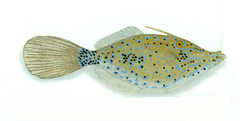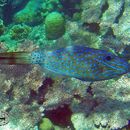Trophic Strategy
provided by Fishbase
Inhabits lagoon and seaward reefs (Ref. 9710). Occasionally are seen under floating objects (Ref. 1602). Feeds on algae, seagrass, hydrozoans, gorgonians, colonial anemones, and tunicates. Feeds on benthic invertebrates and plants (Ref. 33). Omnivore (Ref. 57615, 57616).
Morphology
provided by Fishbase
Dorsal spines (total): 2; Dorsal soft rays (total): 43 - 50; Analspines: 0; Analsoft rays: 46 - 52
- Recorder
- Cristina V. Garilao
Diagnostic Description
provided by Fishbase
Snout concave (Ref. 1602); olive brown to grey in color, juveniles may be yellowish brown with dark spots (Ref. 4421). Elongate, strongly compressed filefish; tan with blue lines and spots. Caudal fin rounded (Ref. 26938) and long (Ref. 13442). Gill opening oblique, pelvic terminus rudimentary or absent; body and head with scattered small black spots (Ref. 13442).
- Recorder
- Cristina V. Garilao
Biology
provided by Fishbase
Inhabit lagoon and seaward reefs (Ref. 9710). Occasionally are seen under floating objects (Ref. 1602). Juveniles may travel with weed rafts in open ocean for a long time and reaching a large size. Adults are usually seen along deep coastal slopes or outer reef drop-offs in about 20 meters depth (Ref. 48637). Benthopelagic (Ref. 58302). Feed on algae, seagrass, hydrozoans, gorgonians, colonial anemones, and tunicates. Caught at the surface using a hand net (Ref. 26165).
Importance
provided by Fishbase
gamefish: yes; aquarium: commercial
分布
provided by The Fish Database of Taiwan
廣泛分布於世界各溫帶及熱帶海域。台灣除西部外,各地皆產。
利用
provided by The Fish Database of Taiwan
主要漁法為圍網及一支釣等,因具厚皮,食用前,通常會先去頭及剝皮,亦是俗稱剝皮魚的由來。唯因食物鰱的關係,食之可能引起中毒;或以其擬態的模樣而常被飼養於水族館中,供人欣賞,是極受歡迎之魚種。
描述
provided by The Fish Database of Taiwan
體長橢圓形,側扁而高;尾柄中長,上下緣明顯雙凹型。吻上緣稍凹,下緣極凹;頭高約等於體高。口端位,唇薄;上下頜齒楔形,上頜齒2列,下頜齒1列。鰓孔在眼前半部下方或眼前緣下方,與體中線成45-50度夾角,鰓孔幾乎全落於體中線下方。體表不甚粗糙,被小鱗,有許多小棘散布直立於整個鱗片上。背鰭兩個,基底分離甚遠,第一背鰭位於鰓孔上方,第I背鰭棘位眼中央或眼前半部上方,棘弱而細長且易斷,棘前緣具一列小突起,棘下方體背之棘溝淺,棘膜極小;第II背鰭棘退化,埋於皮膜下。背鰭鰭條45-47,臀鰭鰭條46-49,其前部皆長於後部,鰭緣截平,臀鰭基稍長於背鰭基;腹鰭膜不明顯,幾乎無;尾鰭長圓形,隨長成而長。
體淺褐色;具許多小黑點與短水平紋;尾鰭色深;餘鰭淡色。
棲地
provided by The Fish Database of Taiwan
主要棲息於潟湖及面海的礁區。通常喜歡停棲於海藻叢,身體採頭下尾上之倒立姿勢,細長的身體配合波動的鰭及體上的斑紋,擬態成海藻而藏身其中。以藻類、海草、水螅蟲、角珊瑚、海葵及被囊動物等為食。
Aluterus scriptus
provided by wikipedia EN
Aluterus scriptus, commonly known as scrawled filefish, broomtail filefish or scribbled leatherjacket, is a marine fish belonging to the family Monacanthidae.
Distribution
This species has a circumtropical repartition, it can be found in the tropical waters from the Atlantic Ocean, the Indian Ocean and the Pacific Ocean.[2]
Habitat
This filefish can be observed in lagoons, coral and rocky reefs, seaweed fields, pinnacles, wrecks and also in open water.[2]
Description

Artist representation of
A. scriptus
Aluterus scriptus is a medium size fish which can grow up to 110 cm (3.6 ft) in length.[3] The body shape looks like an elongated oval, strongly compressed. Its background body coloration is olive-brown or grey depending on its surrounding environment, irregular blue lines and spots are distributed on the body mixed with some black spots mainly on the head. The colors may quickly vary depending on background similar to an octopus's. Fish observed in the Virgin Islands might lie flat on the sand and become pure white or change to any of the other representative colors. The mouth is small and at the end of its pointed snout. Like all the Tetraodontiformes, it has no pelvic fin but has two particular dorsal spines; the first anterior one is long, slender and erectile, located just over the eyes, the second is small and not easy to see but it locks the first one when it is erected.[3] The rounded caudal fin is quite long and can be displayed as a fan.
The juveniles have a yellow with black spots body coloration.[4]
Feeding
Aluterus scriptus is omnivorous and have a large choice for its meals like small crustaceans, algae, gorgonians, sea anemones, tunicates, fire coral,[3] seagrasses and hydrozoans.[5]
Behaviour
Aluterus scriptus is diurnal and is demersal. It is solitary and shy with divers and is rarely seen with others
Images
References

- license
- cc-by-sa-3.0
- copyright
- Wikipedia authors and editors
Aluterus scriptus: Brief Summary
provided by wikipedia EN
Aluterus scriptus, commonly known as scrawled filefish, broomtail filefish or scribbled leatherjacket, is a marine fish belonging to the family Monacanthidae.
- license
- cc-by-sa-3.0
- copyright
- Wikipedia authors and editors
Description
provided by World Register of Marine Species
Occurs in lagoons and on seaward reefs. Solitary, often in open water (Ref. 9710). Feeds on algae, seagrasses, hydrozoans, gorgonians, colonial anemones, and tunicates. Juveniles and occasionallly adults are seen under floating objects (Ref. 1602). Generally common (Ref. 9710).
Froese, R. & D. Pauly (Editors). (2023). FishBase. World Wide Web electronic publication. version (02/2023).
- license
- cc-by-4.0
- copyright
- WoRMS Editorial Board
Diet
provided by World Register of Marine Species
Feeds on algae, seagrass, hydrozoans, gorgonians, colonial anemones, and tunicates.
North-West Atlantic Ocean species (NWARMS)
- license
- cc-by-4.0
- copyright
- WoRMS Editorial Board
Distribution
provided by World Register of Marine Species
circumtropical; Western Atlantic: Nova Scotia, Canada and northern Gulf of Mexico to Brazil
North-West Atlantic Ocean species (NWARMS)
- license
- cc-by-4.0
- copyright
- WoRMS Editorial Board
Habitat
provided by World Register of Marine Species
Inhabits lagoon and seaward reefs.
North-West Atlantic Ocean species (NWARMS)
- license
- cc-by-4.0
- copyright
- WoRMS Editorial Board
Habitat
provided by World Register of Marine Species
benthic
North-West Atlantic Ocean species (NWARMS)
- license
- cc-by-4.0
- copyright
- WoRMS Editorial Board
Habitat
provided by World Register of Marine Species
Known from seamounts and knolls
Stocks, K. 2009. Seamounts Online: an online information system for seamount biology. Version 2009-1. World Wide Web electronic publication.
- license
- cc-by-4.0
- copyright
- WoRMS Editorial Board

